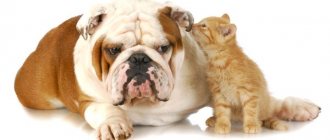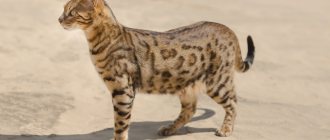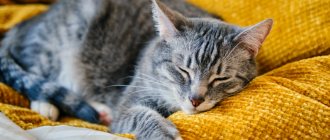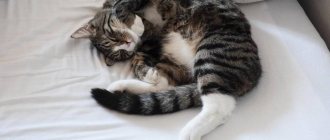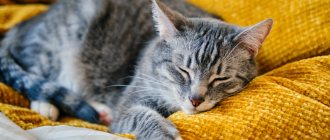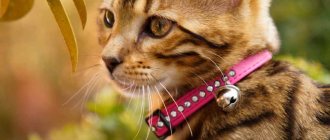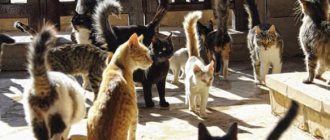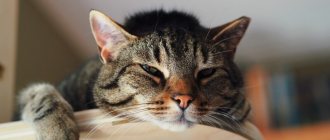Welcome, dear readers, to our website!
Here you can find out many interesting and incendiary stories, many facts and explanations about the world. On our website you will find a lot of useful and interesting information from various fields of science, sports, nature, animals and much more. Read and share with friends!
In this article we will find out why dogs don’t like cats.
There are many different myths about why dogs don't like cats. The real reasons for this attitude can be explained by people who study the habits of domestic animals. In their opinion, the hostility of pets towards each other has a logical basis.
Along the roads of fairy tales
A meeting between purrs and dogs is rarely peaceful. Hissing and snarling, the cat rushes to the saving tree, and the poor owner can hardly restrain the dog, inspired by yet another hatred. Legends are used to explain the reason for dog behavior.
Legend one “King’s Decree”
A long time ago, in a kingdom there lived a dog. Seeing a child in trouble, the four-legged creature rushed to the rescue and, as it turned out later, saved the princess. The king was very grateful to the dog and issued a new decree in gratitude.
According to the new law, all dogs in the kingdom had to have a home and excellent food. When the decree was signed, a problem arose, because all the dogs in the kingdom had to be notified of the innovation. The king's advisor decided to tie the document to the hero dog's tail and let him go free to roam.
To celebrate, the dog went to his friends. Having learned the good news, the four-legged dogs threw a dog feast and celebrated until late. In order not to lose the treasured paper, the friends took it off the dog’s tail and gave it to the cat. Purr was entrusted with following the decree while the dogs were having fun.
Out of envy or by coincidence, the cat did not save the document. The next morning, when the hero dog decided to announce the news throughout the kingdom, the cat did not have any paper. The cat justified himself by saying that the decree was stolen by mice.
The dog's friends got so angry that they rushed at the poor cat and almost tore her to shreds. From that day on, dogs began to hate envious cats, and the purrs of thieves began to hate mice. Centuries passed, but the dogs never lost hope of finding the king's decree.
Legend two “Underwater world”
A long time ago, all dogs lived in the underwater kingdom, but they dreamed of seeing the sun every day, running on land and making friends with other animals. God heard the pleas of the four-legged animals and decided to help, provided that the dogs passed the test.
God appointed a trial period for a year, dogs who liked living on earth could stay, and those who were disappointed had to return home. Naturally, emigrants had to show exemplary behavior and listen to God.
On the cherished day, packs of dogs came out onto land. The leader had a pass that allowed those who wished to return home to the underwater kingdom after a year. In order not to be distracted by formalities, the dogs gave the document to the wise cat for safekeeping.
A year later it was discovered that there were no documents and all the dogs were forced to remain on land. The cat made the excuse that the papers were stolen by mice. Since then, dogs who wanted to return to the underwater world have been chasing cats in the hope of getting a pass home. Cats chase mice to return what they stole and stop the dogs from chasing them.
Legend three "Magic Ring"
In one kingdom there lived a poor man. As if by the dictates of evil fate, the poor man was unlucky in life. He sows wheat, but it doesn’t sprout, he goes fishing, but the fish swim around the nets, he gets chickens... so they run away.
One day, in order to get food, a poor man went into the forest to pick mushrooms and berries. While looking for fruits, the man saw something shiny in the bushes. Having pulled out the find, the poor man discovered that it was a ring, and not just a simple one, but a magical one that brought good luck.
Having put on the ring, the poor man continued to live as before, but everything began to work out for him. The wheat began to sprout, the fish went into the net on their own, and the laying hens returned home. A poor man had a cat and a dog.
The cat was a talkative braggart and gossip. One day, when she came to visit a rich merchant, the purr blurted out her owner’s secret. An envious rich man broke into the poor man's house at night and took the magic ring by force.
The cat was tormented by her conscience and she persuaded the dog to take a desperate step. The four-legged creatures snuck into the rich man's mansion at night and stole the ring. The poor old dog was so nervous that upon arriving home he immediately fell asleep, and the cunning cat woke up the owner. Having given the ring, the cat purred that it was the dog who told the rich man about the ring, and she, brave and courageous, risked her life to save the magical jewelry.
In the morning, the dog, who did not understand anything, found himself out of favor and on a chain. From that day on, the dog received only scraps and kicks from the poor man, he was very offended by the four-legged “traitor”. The cunning cat began to live in the house and receive all kinds of benefits; she never regretted her action and teased the dog.
One day the dog broke loose and decided to deal with the traitor. The dog chased the cat for so long that they disappeared from sight. The cat managed to escape the reprisal, but since then, all the dogs have harbored a grudge against the purr and drive them away as soon as they see them.
Legend four "Hat"
In the high mountains lived a brave and hardworking shepherd dog. On the snowy mountain ridges the weather was cold, but without a shepherd the sheep were lost and defenseless. The dog faithfully performed its service, and in order not to freeze, it wore a warm hat with earflaps. One day, during a strong storm, a gust of wind tore the shepherd’s hat off the head and carried it away in an unknown direction.
The upset and frozen dog took the excellent skin and went to the cat, who sewed things to order. Having given the skin, the dog asked to make a hat with ties so that the wind could not tear it off his head. The sly cat widened his eyes, said that this was a very difficult job, negotiated a higher payment and promised to complete the order in a week. Murlyka was so happy about the generous reward that he abandoned his work and went to have fun. Arriving at the cat's doorstep a week later, the dog discovered that his order was not ready, the cat had not even started work.
The dog got angry and started growling, and the frightened cat promised to give him the finished hat in 3 days. The dog had no choice, she agreed and left.
The seriously frightened cat cut and sewed all night; he finished the hat by morning and was just about to sleep when there was a knock on the door. A rich goat stood on the threshold; he needed a new hat. Seeing the dog's order, the goat offered three times as much money and the cat agreed. The goat left wearing a new hat, and the cat went to bed.
When the cold and cold dog came to pick up his order, the cat widened his eyes and said that they had not received any order. The shepherd became furious and rushed at the cat. The cat managed to escape, but since then the dogs have harbored a grudge against the cunning cats, and the four-legged shepherds do not wear hats.
Eternal competitors
According to research by archaeozoologists, the ancestors of cats appeared in Africa, and the ancestors of dogs appeared on the American continent. Over millions of years, they gave rise to numerous species branches, but existed separately, and only after the next tectonic changes, which led to the unification of the continents, did counter migration begin.
The spread and collision of alien predators resulted in fierce competition for territory and food. Over time, the saber-toothed mahairod tigers and dire wolves of the Pleistocene became extinct, but genetic memory keeps modern cats and dogs still at odds.
Official theory
There are many more interesting myths and tales among the people about the reasons for mutual dislike between animals. But these are just fairy tales. People who study the habits of pets give more plausible explanations for the cause of hostility: Different behavior.
A cat and a dog are diametrically opposed creatures. The dog is a noisy creature that loves to run, bark, and frolic. Let your dog into an unfamiliar apartment, and he will immediately rush to explore and inspect the rooms.
And a calm, unperturbed adult cat prefers to lie more, looking around. She is characterized by innate isolation and indifference. Philosophers! But this behavior is typical of cats who are wise in life - young fluffies behave differently.
Curious dogs, wanting to get to know the cats, run towards them. Outraged by the shamelessness, the cats quickly run away, trying to scare off the impudent ones with their hissing and raised fur. This provokes the mischievous dogs even more – a fun chase begins.
Here we should also take into account the “Jewish” character of the purrs, who consider the place in which they live (a house, an apartment and even a street) to be their personal, inviolable property. The arrogance of dogs is immediately suppressed - cats aggressively defend their territory.
"Predatory" legacy
Dogs are driven to chase cats by an innate instinct that is transmitted genetically. Dogs are hunters by nature and will run after any moving object. Hunting habits intensify when the dog is outdoors. There is a similar, but diametrically opposed theory:
The wild ancestors of cats (lions, tigers, panthers, leopards) always pursued small relatives of dogs (hyenas, jackals, coyotes).
The fear of big cats is ingrained in the subconscious of canines.
Seeing the little purrs, the barking pets begin to take revenge. Instincts are awakened by the smell of a cat.
Unpleasant Memories
Sometimes the kitty is quite peaceful and doesn’t mind playing with the dog. But the dog refuses the friendly relationship and snaps at the cat. This reaction is caused by unpleasant memories (a young dog was offended by a cat, scratching a curious person on the nose). The dog grew up, but the hostility and fear of purrs remained, fixed in the subconscious.
Owner's character
Owners of tailed pets are also capable of developing a hostile attitude towards cats. If a person is loyal to purrs, the dog, looking at him, will not show negative emotions.
But as soon as the owner demonstrates hostility towards felines, the dog duplicates human feelings. Enmity appears between pets. This is interesting.
Speaking about the difference in the behavior of animals, one curious feature was noticed - verbal contact. Dogs and cats have diametrically different body signals:
- A dog's tail wagging means interest and affection. In cats, tail movements indicate irritation or danger.
- When cats purr, they express pleasure. And the grumbling of dogs means a threat and a warning of an attack.
- If the dog raises his paw, he offers to play. The cat perceives this as a threatening action.
- Cat-like arching is a pose that signals an upcoming attack. And the dog, who does not understand this, reaches out to sniff the strange creature or lick it, getting hit in the face with a paw with sharp claws.
Common Mistakes
Inexperienced owners often do not know what to do in a given situation, which leads to the following mistakes:
- Poor nutrition: if everyone eats at the same time and nearby, then someone will inevitably try to steal food from someone else’s plate.
- Uncontrolled first meeting: some let the cat and dog communicate freely, not thinking that this could develop into a fight.
- Lack of separate resting places: cats are introverts by nature. Long communication will infuriate the pet and can lead to aggression. It is advisable to give the cat its place on a hill.
- Playing off animals: they will remember a fight that happens once for the rest of their stay, so clashes should not be allowed.
Sources:
https://dog-blog.ru/kak-podruzhit-koshku-s-sobakoj/ https://astrafarm.com/kak-koshka-s-sobakoy-kak-podruzhit-pitomcev-v-dome https://mrkot .com/kak-podruzhit-koshku-s-sobakoi
Differences in character and behavior
Despite the fact that both companion animals domesticated by humans belong to the order of carnivores, in life they are direct opposites. The cat walks “on its own”; it loves solitude, silence, tranquility and constancy. Her role is that of an outside observer of what is happening, demanding attention to her person only if it is necessary to satisfy her personal needs.
A dog, on the contrary, is a social animal; it loves attention and communication. She needs to run, bark, and be aware of everything going on in the house and outside it. It is difficult to find a dog that expresses indifference to its owner with its entire appearance, but among the cute representatives of cats it will not be difficult.
This feature of pets explains the reluctance of cats to make contact with dogs. A curious puppy runs up to the cat, showing interest and a desire to get to know the unknown creature better, and the cat perceives this behavior as impudence and a violation of its personal space.
She is not afraid of the puppy, she just doesn't like his presence. The result of the meeting may be a menacing hiss, an arched back, sharp claws or a chase.
But if a large pack of dogs approaches a cat, it will not show heroism, having correctly assessed the situation and its strengths, it will prefer to flee.
The main reasons for hostility between cats and dogs
Animal psychologists have identified 5 main reasons explaining the dislike between a dog and a cat:
- The cat avoids communication. This leads to the dog actively trying to make friends and causing even more irritation. Sometimes the dog gets so playful and starts chasing the cat that it looks more like aggression than a desire to communicate.
- Dogs with developed hostility and bitter experience (pit bull, bull terrier). This case is more often typical for fighting breeds, which have a subconscious level of suspicion towards any other species. Enmity also arises after an unsuccessful meeting, for example, a cat severely scratched a dog or scared it.
- Hunting breeds (beagles, dachshunds). These dogs at the genetic level equate the cat to prey status. For them there is no difference between a raccoon, a fox or a cat.
- Incorrect socialization. This mistake is made by the owners when a new family member appears. Therefore, when a puppy or kitten is brought into the home, it takes patience and skill to ensure that the animals become friends with older members of the pack. Often 1 week is enough for the dog and cat to find a common language.
- A special enzyme. British scientists have discovered that cats secrete a substance that can cause aggression and agitation in dogs. However, this reason does not appear in all representatives.
Instinct
In an effort to wean pets from conflict and teach them to love each other at least a little, the owner should not forget about natural instincts. The hunting instinct plays an important role, prompting dogs to chase cats and other animals. But the purrs needlessly begin to fear the dog chasing them. Most often, he is interested in the process of the chase itself, the desire to catch up with the victim, and he does not harm the captured neighbor in the territory.
There is a theory that tells about the past (“predatory”) heritage of cats, whose ancestors were larger than their wild relatives of dogs and often attacked them. Hence the hostility towards cats, which is preserved at the genetic level and encourages the dog to take revenge on the “crushed tiger.”
Remember all
Another reason why dogs don’t like cats is often the good memory that all dogs have. If a dog is quite belligerent against a cat, he angers and irritates it, which means that he has already experienced a bad experience of meeting a purring dog, in which the dog could have been injured (often cats, desperately defending themselves, deeply scratch the noses of curious dogs and injure the mucous membrane of the eyes).
How can a self-respecting dog forgive and forget this? There are no options here - for the pain and humiliation experienced, the dog will begin to take revenge on all the cats in a row.
Difference of worldviews
Our pets are radically different in their way of life, borrowed from their wild ancestors. A cat is a solitary and independent creature, independently obtaining its own food and not needing anyone’s protection or help. A dog is always a member of the pack and cannot imagine his life without communicating with his own kind.
But between the lifestyles of cats and dogs there is a common point of contact, which is also a stumbling block. Both fiercely defend their territory, not allowing outsiders to violate its borders. In this struggle for hunting grounds, cats traditionally suffer defeat, since a single individual is unable to resist a pack. That is why dogs, which outnumber cats in number and size, always find themselves in the role of hunter, giving free rein to instinct.
But the strange thing is that the cat, constantly being “in the skin” of the victim, has absolutely no fear of its pursuer.
When watching a chase, you often get the feeling that the purr is running away simply because it is meant to be so by nature. The same can be said about a dog, which, sometimes unexpectedly catching up with an enemy, often gets lost and does not know what to do next.
That was a long time ago…
And again about genetic memory. She seems to be the only explanation for the dog's eternal pursuit of the cat. Some childish question that excites the minds of adults and serious people, to which, apparently, there is no clear answer: “Why don’t dogs like cats?”
Some semblance of an adequate explanation can be found in the prehistoric period, when saber-toothed tigers (one of the most dangerous representatives of the cat family) walked the earth and brutally exterminated the canine family.
Dogs in those days were not distinguished by their gigantic sizes, they also did not have huge “saber” teeth, so many of them fell victims to ruthless “cats”, which were superior to dogs in size, sharpness of teeth, and cruelty.
And now, when the cats have “shrinked” to the size required by the dogs, they took a kind of carte blanche and considered themselves authorized to avenge the death of their ancient ancestors.
Exceptions to the rules
It turns out that not all dogs dislike cats. There are breeds that adore fluffy purrs. These include:
- Papillon.
- Bichon Frize.
- Maltese.
- Basset Hound.
- Pug.
- German boxer.
- Newfoundland;
- Golden retriever.
In representatives of some breeds, hunting and fighting instincts cannot be suppressed through education. Owners of pit bulls, greyhounds, and Parson-Russell terriers will have to train their pets, teaching them not to pay attention to cats and not to succumb to their provocations.
Mr. Cat recommends: tips for first meeting
Even before meeting, pets should be taught to adequately perceive representatives of another species. So, when walking, you need to scold them for barking towards cats or reward them for being friendly. In the future, the success of reconciling pets will depend on following the following tips:
- It is necessary to teach your pet the “Near” and “Sit” commands as early as possible, otherwise it will be difficult to control him.
- Cat's nails should be trimmed regularly.
- You cannot physically punish your pets.
- At the first signs of friendship between pets, you should not rush to arrange for them to live together. Animals left alone can quarrel and fight.
- When choosing a puppy in a shelter, it is important to find out from the workers which of the wards reacts calmer to cats.
- The most aggressive dogs towards cats are hunting dogs. Owners of such breeds should think carefully before making such a serious decision.
Advantage of the Pack
The joint actions of social animals, which are canines, have many advantages over individualistic cats, who are forced to independently take care of their food and safety:
- A threat to singles . Despite caution and developed instincts, small and medium-sized cats in nature become frequent prey for canines. Thus, the young of the European forest cat are devoured by wolves, foxes and jackals, the slow-moving Pallas cats are successfully hunted by wolves, and the light-footed coyote easily catches up and kills stray cats. A lynx, although it weighs one and a half to two times less than a wolf, poses a serious danger in single combat with it. At the same time, wolves hunting in a pack surround the fleeing lynx, attack in a group and tear it to shreds. Hunters know that in places where there are a lot of wolves, “the lynx doesn’t stick around.” A seasoned lynx, scared from its resting place, flees from a pack of hunting dogs and can run up to 4-6 km before its strength begins to run out. The overtaken animal accurately assesses the situation and, being pursued by one dog, takes up a perimeter defense and fights on the ground. Moving away from the pack, the lynx uses a trivial cat trick and climbs a tree, hoping to sit there. If a shot from a hunter who arrives in time does not kill it outright, then a wounded cat falling down can seriously injure and even kill the dog, desperately clinging to life.
- Run, murka, run! The pack lifestyle allowed dogs to occupy a dominant position even in the conditions of the “concrete jungle,” forcing cats to habitually retreat. Undoubtedly, the difference in size plays a significant role, but even terriers weighing 5-8 kg frantically chase the neighbor's cats, feeling like they are the masters of the area. Thanks to its flexibility and maneuverability, the running cat demonstrates the skill of parkour, avoiding obstacles and climbing to a saving tree or other height inaccessible to the enemy. A single chase most often turns out to be fruitless, but a flock can push the cat away from the shelter and collectively work for destruction.
The struggle for food resources
In nature, the diet of canines and cats is very wide, including dozens of species: from deer and hares to mice, lizards and even insects, and only big cats hunt exclusively large mammals. In times of hunger, both cats and dogs can eat carrion, without disdaining dead animals and the remains of someone else's dinner. And only the cheetah's menu consists of fresh meat from freshly caught prey.
In human society, cats and dogs also compete for food. But while stray dogs tend to eat garbage or devour puppies and weakened relatives, cats easily adapt to any environmental conditions, quickly run wild and hunt successfully.
Even those cats that live in the house, but are released by their owners to walk on their own, on average catch 60 small animals per year, including mice, birds and rats.
Fight for territory
The domestic cat has a pronounced territorial instinct, illustrating the saying that whiskered tabby cats are more attached to a place than to their owner. Thus, Murka clearly considers an apartment, a private house, and even the entire owner’s yard to be his property.
Mature males are especially vigilant in monitoring their possessions, staging noisy showdowns and brutal fights with strangers.
In the wild, canines and cats living in the same territory are competitive predators, which means they are forced to divide hunting grounds and defend their boundaries:
- Yard cats . The territory of a street cat “walking on its own” is very vast, and not only fellow cats, but also dogs fall into the category of uninvited guests. That is why the cat, comfortably dozing on a bench at “his” entrance, will arch and hiss when he sees the approaching dog.
- Dogs . Dogs, in turn, also diligently mark the territory with urine marks and bark at the aliens. In R. Kipling’s fairy tale, the Dog’s appeal to the Cat sounds like a sign and an oath of eternal hatred: “Walk, walk, but not where I am. Otherwise I’ll bark, run at you and drive you up a tree. And so will all dogs do, from now on and forever and ever.”


